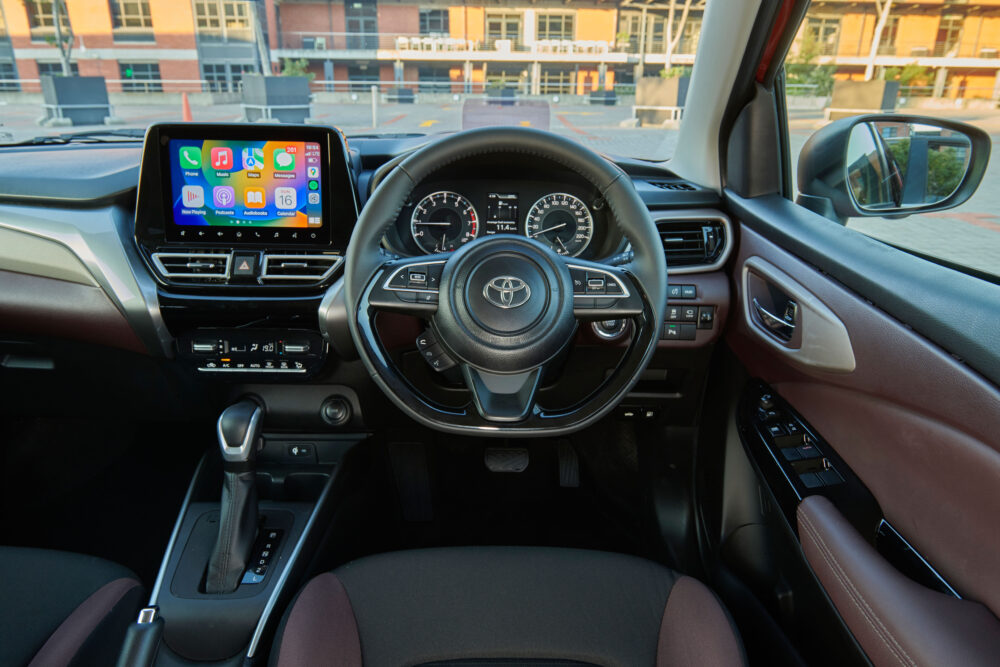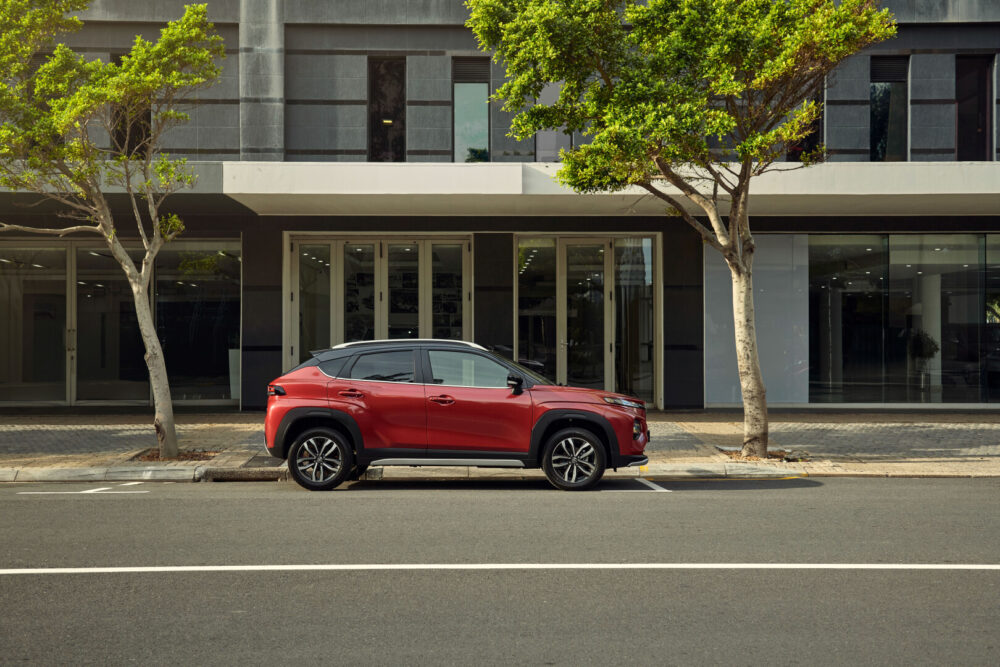Stylish: The Toyota Starlett Cross has an agressive exterior.
Toyota has filled a gap in its line-up with the new Starlet Cross.
Prior to its release, the Toyota hatchback offering ended at the Starlet, and the SUVs began at the Urban Cruiser, but there was nothing to fill the void left between the small hatchback and the spacious but compact SUV.
Through the Starlet Cross, Toyota has managed to bring a crossover vehicle that gives both hatchback and compact SUV vibes in one vehicle — while also being affordable.
But it must be noted that this is one of those Toyota vehicles that is just a rebranded Suzuki Fronx. You would be forgiven for thinking that you were seeing a lot of Starlet Crosses on the road when, in fact, they were Fronx.
This is a result of the mutually beneficial agreement between the two manufacturers, which allows Toyota to gain from Suzuki’s expertise in compact vehicles and rebrand those products. In turn, Suzuki gets access to Toyota’s hybrid and battery electric vehicle technology.
While this does mean we get a lot of similar vehicles from Toyota and Suzuki in the budget segment, it also allows loyalists to stick with the Toyota brand.
But back to the vehicle. The Starlet Cross is very attractive from the outside. The striking front grille, with chrome garnish, commands attention and the thin, sharp headlights put the mean and aggressive front together.
Unlike many other vehicles that put a lot of effort into the front but offer a boring, plain rear, the work done by Toyota to make the back of this vehicle match the front is exceptional.
The two tail lights are connected by a strip that brings the stylish look to the back. This is complemented by a sporty rear skidplate and roof end spoiler for a sporty, yet functional, finish.
The interior
I found the interior interesting. I was not expecting it to be posh, with leather seats and bold colours. Both Suzuki and Toyota like to keep interiors simple but solid.
There was all you needed in a crossover in this vehicle. You will get a 7-inch or 9-inch infotainment system, depending on which variant you choose. It is clear and responsive and comes equipped with Android Auto and Apple CarPlay.
The screen and buttons for the aircon have been tilted towards the driver for improved ergonomics.
There’s a multi-functional steering wheel and all models come standard with three USB chargers, cruise control, leather tilt steering wheel and four speakers.
The XR models include a colour multi-information display; a wireless charger; a push-to-start button and keyless entry; a heads-up display and a 360-degree, panoramic view monitor reverse camera.
Space was also not an issue in this vehicle. As the driver, I was comfortable at all times and, even when I had three adults in the back, they all had no complaints during an hour-long drive from Springs to Lenasia.
The dashboard is stylish, with finishes in charcoal, silver and Bordeaux. But I did have issues with the fact that the hard plastics on the dashboard and door panels feel cheap and look dated.
The other issue was the cloth on the interior roof of the vehicle which was very rough and felt like what you would find in a vehicle straight out of the Eighties.
These things detracted from what is otherwise a stylish and comfortable interior.

The drive
The Toyota Starlet Cross is powered by a 1.5-litre naturally aspirated four-cylinder engine that delivers 77kW of power and 138Nm of torque.
This is the same engine that I criticised in the Suzuki Jimny. When we drove that car, we had the automatic variant, but we opted for the five-speed manual with the Starlet Cross.
The vehicle also comes in a four-speed automatic variant.
Going by the extremely underpowered automatic Jimny, I was glad that I was driving the manual version of the Starlet Cross.
The vehicle picked up speed very nicely in and around town. I actually found it quite nippy around the small streets. However, when I got on to the highway, it struggled slightly.
It became difficult to constantly maintain speeds of 120km/h, especially when facing the tough inclines that the N17 and N12 have to offer. I often found myself dropping a gear to maintain those speeds.
That also makes it tough to overtake. While the gear changes were smooth, I just wasn’t a fan of constantly dropping to fourth to maintain speed on an incline or to pick up speed so I could pass other vehicles.
The ride was smooth — but I would stay away from the automatic variant as they might feel even more sluggish.
There’s no fighting how amazing the Starlet Cross is when it comes to fuel consumption. Toyota claims a figure of 5.6 litres/100km but I managed a lovely 5.2 litres/100km.

Safety
The Toyota Starlet Cross has not been crash-tested by Euro NCAP, so it doesn’t have its safety rating. However, it has a 5-star rating from the New Car Assessment Program for Southeast Asia and, while it’s not explicitly stated, the Starlet Cross uses a strong, lightweight chassis with high-tensile steel, which suggests a focus on safety.
It also comes equipped across all variants with features such as vehicle stability control, hill assist control and ABS with electronic brakeforce distribution, providing enhanced stability and control.
The XR variants come with six airbags and the XS variants only two.
Verdict
Although the Starlet Cross is pretty much a Suzuki Fronx with Toyota branding, I quite like how Toyota have positioned this vehicle in their line-up in South Africa.
It perfectly fits the crossover category and sits slap-bang in the middle of the Starlet and Urban Cruiser.
It offers a great alternative to those who are not ready to drive a big car but want something that is not going to be affected by the poor road conditions in South Africa.
Furthermore, it is stylish and compact, but spacious enough for the entire family.
The Toyota Starlet Cross is available in four models: Xs manual (R299 900), Xs automatic (R322 300), XR manual (R339 300) and XR automatic (R359 300).